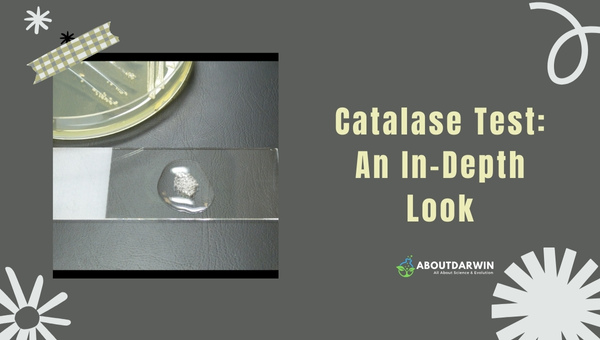Physical Address
304 North Cardinal St.
Dorchester Center, MA 02124
As an introduction, I want you to imagine a microscopic world teeming with activity beyond our human sight. In this unseen universe, bacteria – the oldest form of life on Earth – thrive and survive using different survival strategies.
One valuable strategy involves the use of an enzyme known as catalase to neutralize harmful substances inside their tiny bodies. It’s fascinating, isn’t it? This is where the Catalase Test comes into play.
In simple terms, the ‘Catalase Test’ is a straightforward and effective method used in laboratories worldwide to identify whether certain types of bacteria produce this important enzyme – catalase.
To further your understanding and satiate your scientific curiosity about this test, let me walk you through what the Catalase Test entails – its principle, uses, how it’s done (the procedure), result interpretation, and even some precautions to ensure accuracy during testing.
Contents
Diving headfirst into the world of microbiology, we find ourselves immersed in complex but fascinating enzymatic reactions—one of these being the catalase reaction in bacteria. This is where the main principle behind the Catalase Test lies.

It essentially looks for bubbles—yes, you heard me right! The formation of oxygen gas bubbles indicates that a strain of bacteria produces catalase as it breaks down hydrogen peroxide, a potent toxin.
I know you might be thinking – “Alright, but why should I care about this Catalase Test?” Great question! The test is crucial in identifying and differentiating between specific types of bacteria.
In fact, this test aids in diagnosing serious diseases like Staphylococcus aureus infections, which can cause conditions from minor skin infections to more severe diseases like pneumonia or meningitis. Trust me when I say—understanding this simple test can make a world of difference!
A nod to our high school chemistry classes, the principle of the Catalase Test fundamentally revolves around a biochemical reaction. Are you ready for a fun fact? Catalase is an enzyme that breaks down hydrogen peroxide—a harmful byproduct in cells—into harmless water and oxygen.
This enzymatic superhero protects bacteria, helping them evade harm caused by their own metabolic processes!
Now, here’s where it gets interesting. In a laboratory setting, when we perform a Catalase Test, we intentionally expose bacteria to hydrogen peroxide. If these microscopic beasts are equipped with catalase—their shield against this chemical—they immediately get to work!
They break down hydrogen peroxide and spit out bubbles of oxygen gas as proof of their process – et voilà! That’s your positive result right there—bubbly evidence of catalase at work! Remember – no bubbles mean no catalase, making this test straightforward to interpret yet powerfully insightful!
Also Read: Identification and Biochemical Testing of Bacillus cereus
Now that we’ve talked about why the Catalase Test is so essential let’s get into the nitty gritty – the actual testing procedure. I promise it’s not as scary as it might sound! Just like any scientific method, conducting a Catalase Test is all about precision and attention to detail.
Every so often in life and microbiology, simplicity yields tremendous value. That’s absolutely true for the Catalase Test! The procedure doesn’t involve high-tech machines or tools – it can be done with a simple microscope slide and some bacteria. So come along, let’s walk through how you would carry out a one-of-a-kind detective work at this microscopic level!
Before diving into the execution of the Catalase Test, preparation is key. Here are a few considerations:
Once prepared, it’s time to get down to business! Just follow these simple steps:
And just like that, congratulations on completing your enzymatic detective work through catalase testing!
Alright, so you’ve successfully completed your Catalase Test – but what’s next? This is where we dive into result interpretation, a crucial stage that turns our microscopic detective work into tangible knowledge.
Catalase Test results are relatively straightforward to understand. Here’s your cheat sheet:
Remember, each reaction—positive or negative—directs us towards different families of microorganisms and thus guides us in crucial decision-making, from disease diagnoses to understanding how life thrives at microscopic levels!
Also Read: Sun Fusion: The Process And The Power Of Solar Energy
As with any scientific test, accuracy is paramount. Here are a few crucial precautions to keep in mind:

Before embarking on the Catalase Test, here’s some handy advice:
Sometimes mistakes do happen, but you can dodge these common errors:
Also Read: Who Owns MyHeritage? Unveiling the Ownership Mystery!
Not at all! No bubble formation simply suggests that your bacterial sample does not produce catalase, indicating it belongs to a species that is ‘catalase-negative,’ like Streptococcus!
Older colonies may have damaged or impaired cells, leading to inaccurate results; hence, it’s best to stick with fresh cultures!
While typically safe, hydrogen peroxide can cause skin and eye irritation; always wear safety gear during testing!
For reliable results, use a 3% hydrogen peroxide solution; higher concentrations may give false-positive results.
A positive Catalase Test indicates that the bacteria produce the enzyme catalase, suggesting they belong to a group known as ‘catalase-positive’ like Staphylococcus.
Also Read: Unlock Your Roots: Explore Free Genealogy Websites Today
And there you have it! We’ve embarked on a journey through the microscopic world of bacteria, with the Catalase Test leading us toward unraveling their secrets.
This modest test — unassuming yet undeniably powerful—enables us to identify and differentiate between various types of bacteria that swaddle our planet and our lives.
In conclusion, whether you’re simply fascinated by microbiology or partaking in critical diagnostics work, the Catalase Test offers crucial insight into the unseen world around (and within) us.
Accuracy, attention to detail, and a thorough understanding of principles all combine to make each catalase detective work truly remarkable!